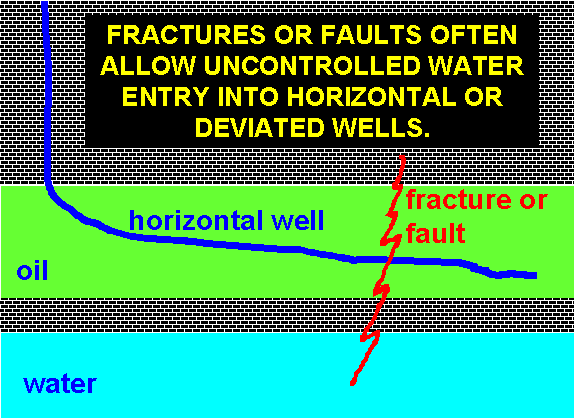Faults or Fractures that Cross-Deviated or Horizontal Wells
Problem 8 in Table 1

Deviated and horizontal wells are prone to intersect faults or fractures. If these faults or fractures connect to an aquifer, water production can jeopardize the well.59 Often, the completions of these wells severely limits the use of mechanical methods to control fluid entry. In contrast, gel treatments can provide a viable solution to this type of problem. However, conventional gelant treatments are not the desired form of remediation in this case. In a conventional gelant treatment, a fluid gelant solution is injected that flows down the well into the target fracture or fault and also leaks off into the porous rock around the wellbore and the fracture or fault. The resultant gel may plug or severely restrict water entry into the fracture or fault. Unfortunately, the gelant will also flow into the exposed hydrocarbon bearing rock all along the well during the placement process. Consequently after gelation, oil productivity can be damaged as much as water productivity. Alternatively, a formed gel can be pumped down the well and selectively placed in the fracture.39,59,61 The gel formulation may exist as an uncrosslinked fluid at the wellhead, so long as significant gelation occurs before the gelant reaches the oil zone. Then, because formed gels do not enter or flow through porous rock,67 damage to oil productivity can be minimized. In contrast, the gel can extrude selectively into and plug the fracture or fault. When the well is returned to production, gel remaining in the wellbore can often flow back to the surface. If designed properly, gel in the fault or fracture will remain in place because the fracture width is much smaller than the diameter of the wellbore. (The pressure gradient required to mobilize formed gels varies inversely with the square of fracture width or tube diameter.39) Alternatively, coiled tubing can be used to circulate gel out from the wellbore.36 (In practice, water, oil, or an uncrosslinked polymer solution is often injected immediately after the gel in an attempt to displace gel from the wellbore into the fracture.59 Since this displacement is unstable, its effectiveness can be questioned.)
If the water production problem is caused by a single fracture or fault that intersects the horizontal wellbore, the distance of gel penetration into the fracture need not be particularly large.68 In this case, the benefit gained varies approximately logarithmically with the distance of gel penetration.61 However, this conclusion is specific to one particular scenario—i.e., a single fault or fracture intersecting a horizontal well. The conclusion may not be valid for vertical wells or if multiple fractures or faults intersect a horizontal well, or if a natural fracture system is present. Furthermore, even for the case of a single fault or fracture that intersects a horizontal well, some value may be realized by injecting a significant amount of gel to mitigate the possibility of gel washout after the well is returned to production.
For horizontal wells that cross individual faults or fractures, simple calculations based on productivity data can give at least a rudimentary indication of the width of the fracture that causes the excess water production.61 The calculations can also give an idea of how far the gel should penetrate to provide a beneficial effect.39 Using laboratory data coupled with field data collected before, during, and after gel injection of similar gel treatments, the calculations can also give an indication of how far the gel actually penetrated into the fracture.61 To successfully make these determinations, accurate flowing and static downhole pressures are critical measurements that must be obtained during field applications of these gel treatments.
In vertical fractures that cut through vertical wells, gel flow in the fracture is generally linear. However, in vertical fractures that cut through horizontal wells, the flow geometry is radial (at least, near the well). During gel extrusion through fractures of a given width, the pressure gradient and degree of gel dehydration were nearly independent of position and velocity during both radial and linear flow.69 Because the pressure gradient during gel extrusion is almost independent of injection flux, the pressure gradient is nearly independent of radial position from the wellbore. Thus, the distance of gel penetration from the wellbore (Lgel or rgel) can be estimated regardless of whether flow in the fracture is linear or radial.
where Δpwater is the pressure drawdown (i.e., the downhole pressure difference between the wellbore and the formation) during water injection, Δpgel is the pressure drawdown during gel injection, and (dp/dl)gel is the pressure gradient required for gel extrusion through the fracture of interest. As mentioned earlier, the pressure gradient for gel extrusion varies inversely with the square of fracture width.39 For one Cr(III)-acetate-HPAM gel (with 0.5% HPAM) that is commonly used in field applications, the pressure gradient (in psi/ft) for gel extrusion is related to fracture width (in inches) using Eq. 6.
Of course, the coefficient in Eq. 6 (e.g., 0.02) depends on gel composition. More rigid gels exhibit greater coefficients and pressure gradients during extrusion.
Ref. 61 describes the application of the above methodology and equations for fractures and faults in the Prudhoe Bay field. Refs. 59 and 68 provide additional discussion of field applications of gel treatments that were directed at faults that crossed deviated or horizontal wells in Prudhoe Bay and Qatar.